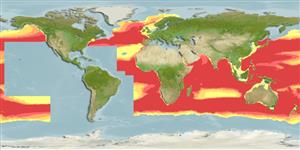Colossendeis macerrima Wilson, 1881
| Native range | All suitable habitat | Point map | Year 2050 |

|
| This map was computer-generated and has not yet been reviewed. |
| Colossendeis macerrima AquaMaps Data sources: GBIF OBIS |
Изображение на Google |
No photo available for this species.
Классификация / Names народные названия | синонимы | CoL | ITIS | WoRMS
Pycnogonida | Pantopoda | Colossendeidae
Environment: milieu / climate zone / пределы глубины / distribution range экология
батипелагический; пределы глубины 52 - 4306 m (ссылка 1844). Polar
Distribution страны | регионы FAO | Ecosystems | места находок | интродукции
Eastern Atlantic and Indo-Pacific: Tonga, Melanesia and Pan oceanic.
Length at first maturity / Size / Weight / Возраст
половая зрелость: Lm ? range ? - ? cm
Краткое описание морфология
Life cycle and mating behavior половая зрелость | размножение | нерест | Eggs | Fecundity | Larvae
Основная ссылка
ссылки | координатор | соавторы
Child, C.A. 1998 The marine fauna of New Zealand: Pycnogonida (sea spiders). NIWA Biodiversity Memoire 109. National Institute of Water and Atmospheric Research (NIWA). Washington, D.C. 20530, USA. 71 p. + Figure 2A-G, 3A-F, 4, 5. (ссылка 9)
Статус Красного Списка МСОП
(ссылка 130435: Version 2025-1)
Статус СИТЕС (ссылка 108899)
CMS (ссылка 116361)
Угроза для людей
Использование человеком
| FishSource |
инструменты
дополнительная информация
состав пищи
потребление пищи
хищники
Max. ages / sizes
Length-weight rel.
Length-length rel.
Размерный состав
Mass conversion
численность
ресурсы в Интернет
BHL | BOLD Systems | CISTI | DiscoverLife | FAO(Publication : search) | Fishipedia | GenBank (Геном, Нуклеотид) | GloBI | Gomexsi | Google Books | Google Scholar | Google | PubMed | Tree of Life | Wikipedia (Вперёд, поиск) | Zoological Record


